American actor William Farnum (1876-1953) was one of the first major movie stars. Nationally acknowledged as a great tragedian on stage in his youth and middle age, Farnum drew ovations for his recitation of Shakespeare. From 1914 to 1925, he was one of the biggest stars in Hollywood, earning $10,000 a week. Farnum's silent pictures include the Westerns The Spoilers(1914) - which culminates in a spectacular saloon fistfight, The Sign of the Cross (1914) and the drama-adventure If I Were King (1921).
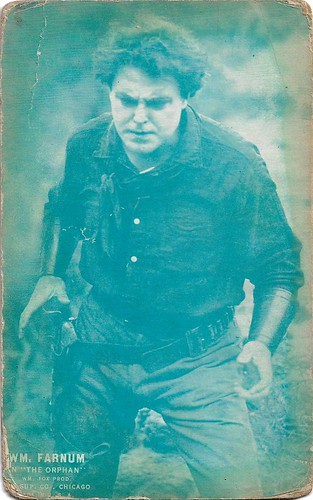
American postcard by Sup. Co., Chicago. Photo: William Fox Productions. William Farnum in The Orphan (J. Gordon Edwards, 1920).
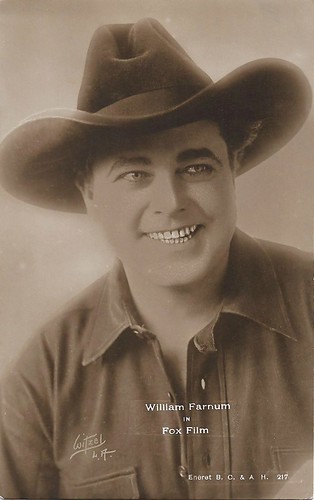
Danish postcard by Eneret B.C. & A.H., no. 217. Photo: Witzel, Los Angeles / Fox Film.
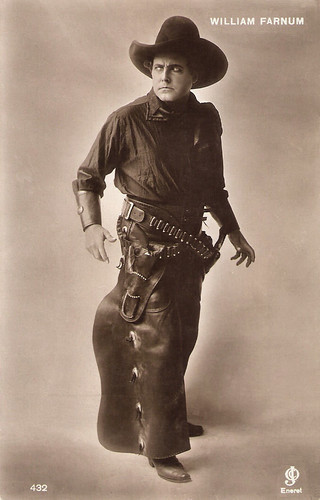
Danish postcard by J. Chr. Olsens Kunstforlag. Eneret, no. 432.
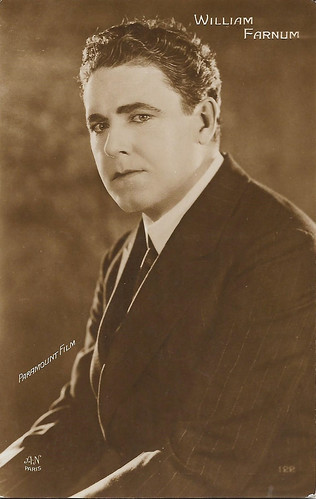
French postcard by A.N., Paris, no. 122. Photo Paramount Film.
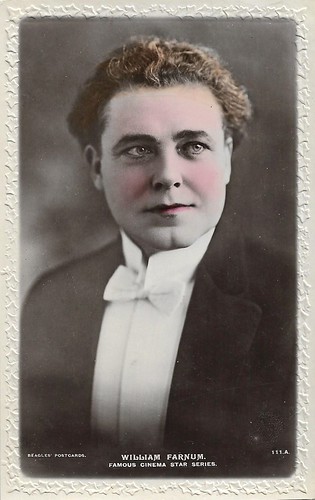
British postcard in the Famous Cinema Star Series by Beagles Postcards, no. 111A.
William Farnum was born in 1876 in Boston, Massachusetts, USA, in a family of actors. His parents, the actors G.D. Farnum and Adela Le Gros, trained William and his two brothers, Dustin and Marshall, in their profession. Dustin Farnum later became a known film actor, while Marshall Farnum became a silent film director who died in 1917.
William made his acting debut at ten in Richmond, Virginia in a production of Julius Caesar, with Edwin Booth playing the title character. His first Broadway appearance was in 1896. He had a major success as the title character of Ben-Hur in 1900. He replaced the original actor, Edward Morgan, who premiered the character in 1899. Farnum toured in Ben-Hur for five years.
Later plays in which Farnum appeared were the costume epic The Prince of India (1906), The White Sister (1909) starring Viola Allen, The Littlest Rebel (1911), co-starring his brother Dustin Farnum and the then nine years old child actress Mary Miles Minter, and Arizona (1913) with Dustin and stage beauty Elsie Ferguson.
So, William Farnum was a ranking stage star when he first came to Hollywood. He made his film debut in the short film The Redemption of David Corson (Frederick A. Thomson, 1914). He played a Quaker who is admired by members of his community for his spiritual ways. He has a crisis of faith when a snake-oil salesman named Dr. Paracelsus (Robert Broderick) arrives in town with a young gipsy named Pepeeta (Constance Mollineaux).
His next film was the Western The Spoilers (Colin Campbell, 1914), the first of many filmed adaptations of Rex Beach's adventure novel of the Alaskan gold rush. Farnum and co-star Tom Santschi staged a classic movie fight which lasted for a full reel. In 1930, Farnum and Santschi coached Gary Cooper and William Boyd in the fight scene for the sound version of The Spoilers (Edwin Carewe, 1930). Other actors influenced by the fistfight scene were Milton Sills and Noah Beery in The Spoilers (Lambert Hillyer, 1923) and Randolph Scott and John Wayne in The Spoilers (Ray Enright, 1942). Farnum's third film is probably his best known, The Sign of the Cross (Frederick A. Thomson, 1914), based on the novel by Wilson Barrett. In this Famous Player production, he played the lead as Marcus Superbus.
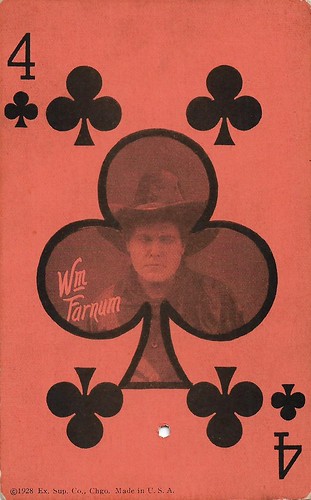
American Arcade postcard by Ex.[Exhibit] Sup[ply]. Co., Chicago, USA, 1928.
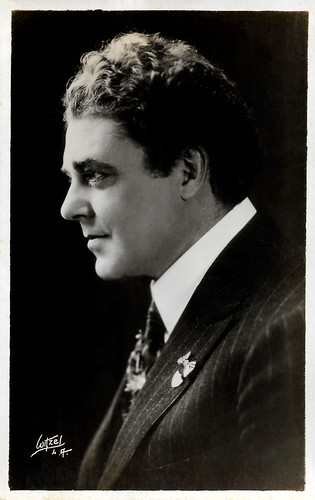
American postcard. Photo: Witzel, L.A.
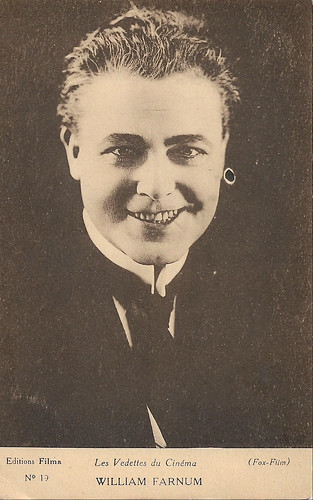
French postcard in the Les Vedettes du Cinéma series by Filma, no. 18. Photo: Fox-Film.
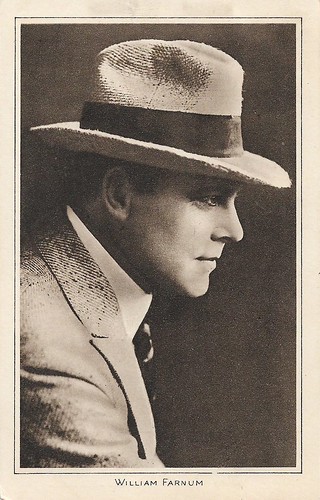
British postcard by 'Pictures' Portrait Gallery, London.
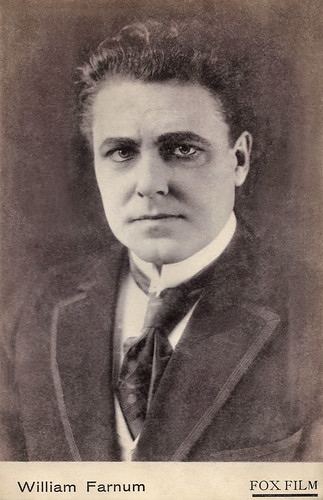
Vintage postcard. Photo: Fox Film.
From 1915 to 1952, William Farnum devoted his life to motion pictures. While becoming one of the biggest sensations in Hollywood, he also became one of the highest-paid actors, earning $10,000 a week at the Fox studio. Farnum's silent pictures included the Western Drag Harlan (J. Gordon Edwards, 1920) and the drama-adventure If I Were King (J. Gordon Edwards, 1921) as the famed French poet and vagabond rogue François Villon. Both films, which he made contracted to Fox Films, have survived.
His way of life in the years of his Hollywood fame helped establish the lavish pattern the world inevitably associated with movie stardom. His yacht was one of the largest, his home and its furnishings, his stables, his automobiles and his entertaining — not to mention his marital trouble — all were in the gaudy tradition. Farnum was married three times. His first wife was actress Mabel Eaton. Farnum had a daughter, Sara Adele, with his second wife, Olive White. He had three children with his third wife, Isabelle Lunds Major, named Isabelle, Elizabeth and William Farnum Jr.
In 1924, while making the drama The Man Who Fights Alone (Wallace Worsley, 1924) at the height of his powers, he was hurt so seriously that his career came almost to a full stop. But he returned to make several silent films and many sound pictures, although he never regained the stature of major stardom. He returned to the stage in 1925 playing Sir Ralph Morgan in The Buccaneer. The following year he appeared in the title role of Julius Caesar and two years later was on Broadway as Banquo in Macbeth.
His film parts in the 1940s and 1950s were mostly small. He played Tubal in Samson and Delilah (Cecil B. DeMille, 1949) with Victor Mature and Hedy Lamarr. He appeared opposite Roy Rogers in Trail of Robin Hood (William Whitney, 1950). His final films were the romantic Western Lone Star (Vincent Sherman, 1952) starring Clark Gable and Ava Gardner, and Jack and the Beanstalk (Jean Yarbrough, 1952), Abbott & Costello's version of the famous fairy tale, about a young boy who trades the family cow for magic beans.
William Farnum died from uraemia and cancer in 1953 at Cedars of Lebanon Hospital. He was interred at Forest Lawn Memorial Park in Glendale, California. Pallbearers were Cecil B. DeMille, Jesse Lasky, Frank Lloyd, Clarence Brown, Charles Coburn and Leo Carillo. The eulogy was read by Pat O'Brien. In 1960, Farnum received a star on the Hollywood Walk of Fame for his contributions to the motion pictures industry at 6322 Hollywood Boulevard.
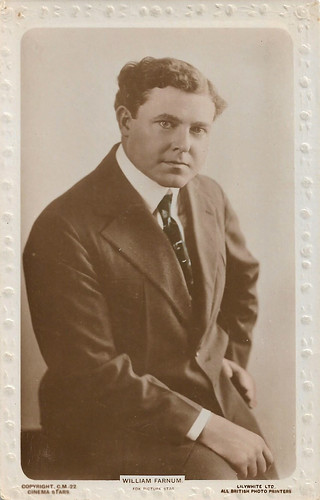
British postcard in the Cinema Stars series by Lilywhite Ltd., no. C.M. 32. Photo: Fox.
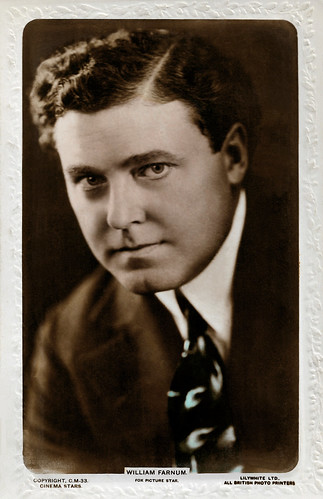
British postcard in the Cinema Stars series by Lilywhite Ltd., no. C.M. 33. Photo: Fox.
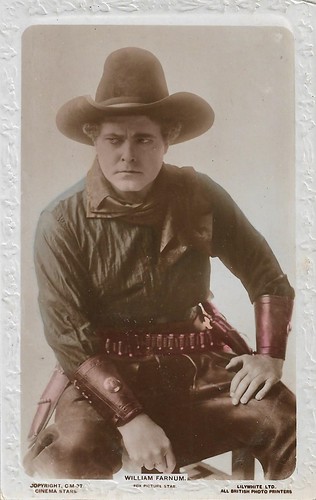
British postcard in the Cinema Stars series by Lilywhite Ltd., no. C.M. 37. Photo: Fox.

British postcard in the Cinema Stars series by Lilywhite Ltd., no. C.M. 54. Photo: Fox.

British postcard in the Cinema Stars series by Lilywhite Ltd., no. C.M. 68. Photo: Fox.
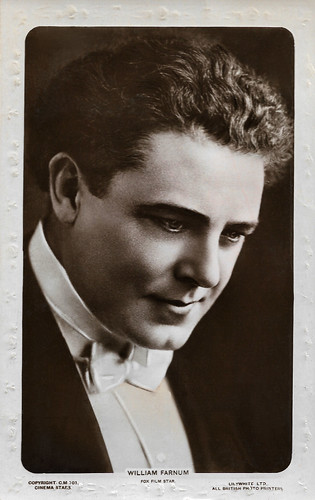
British postcard in the Cinema Stars series by Lilywhite Ltd., no. C.M. 101. Photo: Fox.
Sources: W.K. Waters (IMDb), Los Angeles Times, Wikipedia and IMDb.
This post was last updated on 2 March 2024.

American postcard by Sup. Co., Chicago. Photo: William Fox Productions. William Farnum in The Orphan (J. Gordon Edwards, 1920).

Danish postcard by Eneret B.C. & A.H., no. 217. Photo: Witzel, Los Angeles / Fox Film.

Danish postcard by J. Chr. Olsens Kunstforlag. Eneret, no. 432.

French postcard by A.N., Paris, no. 122. Photo Paramount Film.

British postcard in the Famous Cinema Star Series by Beagles Postcards, no. 111A.
A classic fistfight which lasted for a full reel
William Farnum was born in 1876 in Boston, Massachusetts, USA, in a family of actors. His parents, the actors G.D. Farnum and Adela Le Gros, trained William and his two brothers, Dustin and Marshall, in their profession. Dustin Farnum later became a known film actor, while Marshall Farnum became a silent film director who died in 1917.
William made his acting debut at ten in Richmond, Virginia in a production of Julius Caesar, with Edwin Booth playing the title character. His first Broadway appearance was in 1896. He had a major success as the title character of Ben-Hur in 1900. He replaced the original actor, Edward Morgan, who premiered the character in 1899. Farnum toured in Ben-Hur for five years.
Later plays in which Farnum appeared were the costume epic The Prince of India (1906), The White Sister (1909) starring Viola Allen, The Littlest Rebel (1911), co-starring his brother Dustin Farnum and the then nine years old child actress Mary Miles Minter, and Arizona (1913) with Dustin and stage beauty Elsie Ferguson.
So, William Farnum was a ranking stage star when he first came to Hollywood. He made his film debut in the short film The Redemption of David Corson (Frederick A. Thomson, 1914). He played a Quaker who is admired by members of his community for his spiritual ways. He has a crisis of faith when a snake-oil salesman named Dr. Paracelsus (Robert Broderick) arrives in town with a young gipsy named Pepeeta (Constance Mollineaux).
His next film was the Western The Spoilers (Colin Campbell, 1914), the first of many filmed adaptations of Rex Beach's adventure novel of the Alaskan gold rush. Farnum and co-star Tom Santschi staged a classic movie fight which lasted for a full reel. In 1930, Farnum and Santschi coached Gary Cooper and William Boyd in the fight scene for the sound version of The Spoilers (Edwin Carewe, 1930). Other actors influenced by the fistfight scene were Milton Sills and Noah Beery in The Spoilers (Lambert Hillyer, 1923) and Randolph Scott and John Wayne in The Spoilers (Ray Enright, 1942). Farnum's third film is probably his best known, The Sign of the Cross (Frederick A. Thomson, 1914), based on the novel by Wilson Barrett. In this Famous Player production, he played the lead as Marcus Superbus.

American Arcade postcard by Ex.[Exhibit] Sup[ply]. Co., Chicago, USA, 1928.

American postcard. Photo: Witzel, L.A.

French postcard in the Les Vedettes du Cinéma series by Filma, no. 18. Photo: Fox-Film.

British postcard by 'Pictures' Portrait Gallery, London.

Vintage postcard. Photo: Fox Film.
Becoming one of the biggest sensations in Hollywood
From 1915 to 1952, William Farnum devoted his life to motion pictures. While becoming one of the biggest sensations in Hollywood, he also became one of the highest-paid actors, earning $10,000 a week at the Fox studio. Farnum's silent pictures included the Western Drag Harlan (J. Gordon Edwards, 1920) and the drama-adventure If I Were King (J. Gordon Edwards, 1921) as the famed French poet and vagabond rogue François Villon. Both films, which he made contracted to Fox Films, have survived.
His way of life in the years of his Hollywood fame helped establish the lavish pattern the world inevitably associated with movie stardom. His yacht was one of the largest, his home and its furnishings, his stables, his automobiles and his entertaining — not to mention his marital trouble — all were in the gaudy tradition. Farnum was married three times. His first wife was actress Mabel Eaton. Farnum had a daughter, Sara Adele, with his second wife, Olive White. He had three children with his third wife, Isabelle Lunds Major, named Isabelle, Elizabeth and William Farnum Jr.
In 1924, while making the drama The Man Who Fights Alone (Wallace Worsley, 1924) at the height of his powers, he was hurt so seriously that his career came almost to a full stop. But he returned to make several silent films and many sound pictures, although he never regained the stature of major stardom. He returned to the stage in 1925 playing Sir Ralph Morgan in The Buccaneer. The following year he appeared in the title role of Julius Caesar and two years later was on Broadway as Banquo in Macbeth.
His film parts in the 1940s and 1950s were mostly small. He played Tubal in Samson and Delilah (Cecil B. DeMille, 1949) with Victor Mature and Hedy Lamarr. He appeared opposite Roy Rogers in Trail of Robin Hood (William Whitney, 1950). His final films were the romantic Western Lone Star (Vincent Sherman, 1952) starring Clark Gable and Ava Gardner, and Jack and the Beanstalk (Jean Yarbrough, 1952), Abbott & Costello's version of the famous fairy tale, about a young boy who trades the family cow for magic beans.
William Farnum died from uraemia and cancer in 1953 at Cedars of Lebanon Hospital. He was interred at Forest Lawn Memorial Park in Glendale, California. Pallbearers were Cecil B. DeMille, Jesse Lasky, Frank Lloyd, Clarence Brown, Charles Coburn and Leo Carillo. The eulogy was read by Pat O'Brien. In 1960, Farnum received a star on the Hollywood Walk of Fame for his contributions to the motion pictures industry at 6322 Hollywood Boulevard.

British postcard in the Cinema Stars series by Lilywhite Ltd., no. C.M. 32. Photo: Fox.

British postcard in the Cinema Stars series by Lilywhite Ltd., no. C.M. 33. Photo: Fox.

British postcard in the Cinema Stars series by Lilywhite Ltd., no. C.M. 37. Photo: Fox.

British postcard in the Cinema Stars series by Lilywhite Ltd., no. C.M. 54. Photo: Fox.

British postcard in the Cinema Stars series by Lilywhite Ltd., no. C.M. 68. Photo: Fox.

British postcard in the Cinema Stars series by Lilywhite Ltd., no. C.M. 101. Photo: Fox.
Sources: W.K. Waters (IMDb), Los Angeles Times, Wikipedia and IMDb.
This post was last updated on 2 March 2024.
No comments:
Post a Comment